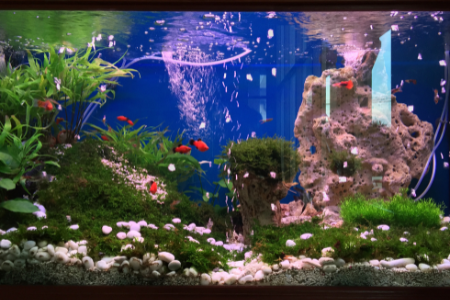
Are you worried about safely bringing your fish along to your new house or apartment? This article has the answers for safe and hassle-free transportation.
Moving with any pet can be stressful, for both you and your animal(s), but it is perhaps most stressful when trying to move an entire aquarium. After all, in addition to potentially dozens of fish that need to be kept in stable, safe water that meets their own parameters, there are also all the plants, small animals, and various pieces of equipment, as well as the large, fragile glass tank itself. Whether you keep salt or freshwater fish, moving an aquarium is a complex and delicate process. It is doable, however, and can be done without much hassle if you follow a few common-sense steps for safely packing, transporting, and transitioning fish from one house to another.
1. Pack your fish carefully.
How you pack your fish will depend a bit on the length and method of your move. However, in general, the best method involves a Styrofoam box and a plastic garbage bag or two. The box can be a specialized fish-moving box from your local aquarium supply or a simple Styrofoam cooler. Use the garbage bag(s) as a liner, making sure to push it as flush with the corners as you can. Plastic containers can be used for shorter moves, but they may be unsafe for longer moves, as the plastic can release toxins into the water and harm your fish. Fill the box about halfway with water from your aquarium, add your fish, and pack it as carefully as possible to avoid jostling or falling. Additionally, try to keep it out of direct sunlight to prevent overheating.
2. Avoid overcrowding and be careful which fish you mix in transport.
It can be tempting, especially if you have a particularly large or crowded aquarium, to attempt to pack as many fish into as few boxes as possible, reduce your workload, and make more room in your transport vehicle. However, overcrowding and inappropriate mixing are two of the biggest dangers to fish while moving. As with populating a community tank, space needs and the proper tankmates will depend on the size and species of your fish; if you’re unsure of the best containers and groups to transport your fish in, check online or ask your local aquarium supply or pet store. Aggressive fish, like cichlids, should always be transported on their own.
3. Don’t feed your fish before or during the move.
Feeding fish leads to poop, and poop creates dirty, potentially toxic water. To avoid having to change out your fish’s water during your move, take advantage of the fact that most fish can safely go about a week without food (though you should double-check this with your specific species). Stop feeding your fish about two days before the move to limit the amount they dirty their water. You should be able to start feeding them again as soon as you have their new tank set up in the new house.
4. Make sure your fish have enough air.
We don’t often think of fish as needing air, since they don’t breathe, per se, but they do require fresh oxygen to keep them alive. It is safest to transport your fish in sealed containers, but you should only fill them halfway with water, leaving the rest of the space for air to keep the water fully oxygenated. Battery-powered air pumps are available to oxygenate your water throughout the trip. Alternatively, you can simply open the containers a few times a day to replace the air supply, which will also give you a chance to check on your fish throughout the trip and make sure they’re traveling well.
5. Keep your water parameters as stable as possible.
Fish, and some species more than others, are incredibly sensitive to changes in their water. Even though it may not be obvious to you, there are likely to be significant differences between the water in your old place and your new one, differences in things like hardness and chemical content that could be stressful and even harmful to your fish. For this reason, you should try to ease your fish into this water transition as much as possible. Bring as much water from your old aquarium with you as you feasibly can and use this water both for transporting your fish and to fill up the tank for the first time in the new house. Cycle in new water each time you do a small changeover, until eventually your fish are full adapted to the new water source.
6. Pack plants, living décor, and small animals separately.
The best way to transport your non-fish aquarium inhabitants will depend on what you have; always research the species or variety before packing it up, and if you’re still unsure about the best practices for a specific specimen, consult your local aquarium supply. In general, though, most plants and small aquarium animals, like shrimp and snails, can be transported in plastic bags with a small amount of aquarium water. If you’re lucky enough to have live coral in your tank, it should be transported in an ice chest that’s about half full of water.
Moving with an aquarium will never be easy or particularly fun, but it can be done. Most importantly, if done right, it can be done without harming or endangering any of the wonderful fish you’ve worked so hard to collect and care for and will continue to enjoy in your new place for years to come.
